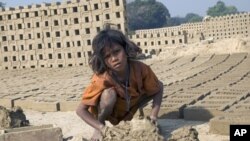In 2002, the International Labor Organization, or ILO, launched the first World Day Against Child Labor, to draw attention to the plight of children in the labor force. Since then, the day's observance every June 12th has been a call to action for those dedicated to ending exploitative child labor.
Though there has been some progress in combating dangerous child labor since that first World Day in 2002, according to the ILO's most recent Global Estimates there are still 215 million children between the ages of 5 and 17 caught in child labor throughout the world, often at the expense of their education. Of these children, 115 million are engaged in hazardous work, working under exploitative conditions that can impact their health and safety, and destroy their chances to live up to their full potential.
Such children labor under hazardous and exploitative conditions in the informal and service sectors and as domestic servants. But it is the agricultural sector that, at 60 percent, employs the highest proportion of children. Many are exposed to pesticides and herbicides without adequate protective gear.
Twenty six percent of the children work in the service sector, selling goods in streets and markets, carrying heavy loads, working in hotels and restaurants, or as domestic servants.
Seven percent of child laborers are employed in such industries as mining and quarrying, small-scale manufacturing and construction. These are often dangerous jobs, exposing them to toxic substances and requiring physical labor often unsuitable for their undeveloped physical stature.
Exploitive child labor impacts the individual child, but also the community as a whole. As U.S. President Barack Obama has noted, "Global child labor perpetuates a cycle of poverty that prevents families and nations from reaching their full potential.” Children who must work instead of going to school fail to acquire the skills and education they need for a better future. Their communities and countries suffer through losses in competitiveness, productivity and potential income.
Such exploitation cannot be stopped by just one strategy. We must all work to address its root causes – including poverty, a lack of decent work for parents, weak enforcement of labor laws, and a lack of educational opportunities for children. All children, irrespective of their gender, economic or ethnic background should have the opportunity to attend school and live up to their full potential.
As U.S. President Barack Obama has said, "We must stand united in opposition to child labor and recommit ourselves to ending this practice in all its forms – today and every day."
World Day Against Child Labor

215 million children between the ages of 5 and 17 are caught in child labor throughout the world, often at the expense of their education.














